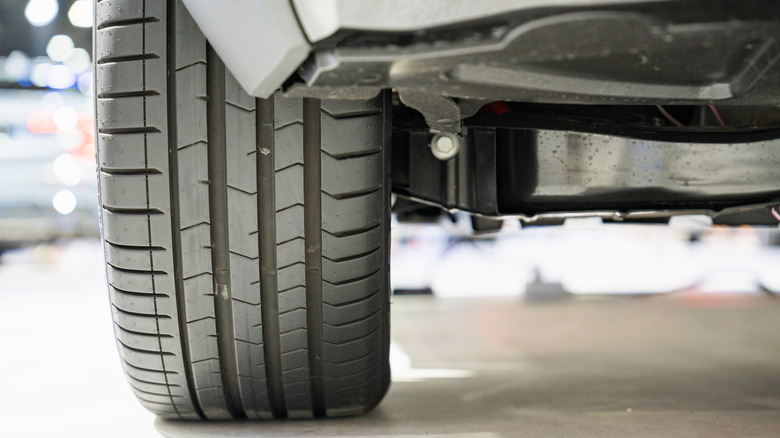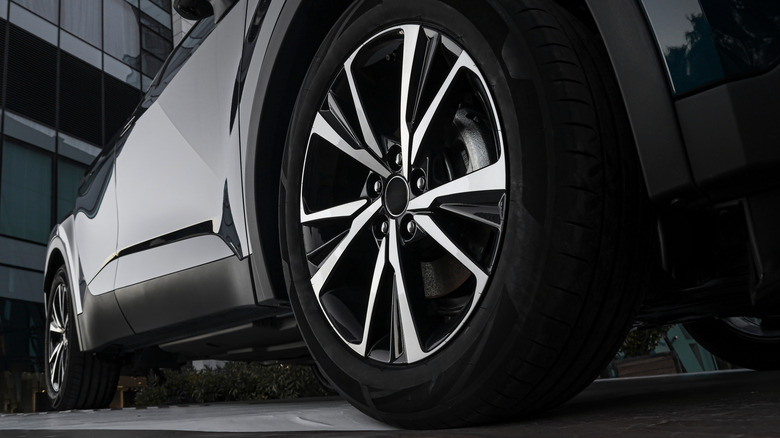The Mistake You Might Be Making With New Tires
It's easy to go into autopilot mode following certain car maintenance activities, like getting an oil change or replacing an air filter. You just hop in the car and go. However, other types of work require more attention at the outset, including getting new tires. It's easy to assume that new tires are ready to deliver peak traction the moment they touch the pavement, but the reality is far different.
In fact, new tires are likely to deliver reduced grip for the first few hundred miles due to stiff treads and leftover chemicals from the manufacturing process. These factors fade away as the miles accumulate, but it's something every driver with new rubber in the corners should consider. Tire Rack advises that "Your new tires require a break-in period to ensure that they deliver their normal ride quality and maximum performance."
Yet that initial conditioning timeframe is more than just being cautious with the brakes; it's also about understanding what happens to the tires before and after installation. Tire companies use mold release agents and protective solutions during manufacturing. At the same time, rigid tread blocks can create an abnormal handling experience. Until these road contact surfaces throw off the chemicals and accumulate wear, traction, braking, and steering may be less than ideal. Here's what all that means, regardless of whether you're buying expensive tires or more budget-friendly treads.
Why new tires don't perform their best right away
New tires don't start in peak driving condition when first mounted on your car, even if they've been properly balanced. Manufacturers use a release lubricant that helps separate the tire from the mold. The residue remains on the tire's surfaces (including the treads), affecting traction but eventually wears away as you drive. In addition, tire makers apply antioxidants to help preserve the rubber during storage and limit the effects of exposure to temperature extremes and the environment.
Diminished tire performance also occurs because you're driving on fresh treads. These tall and rigid tread blocks don't fully flex during cornering. The tire industry calls this "tread squirm," where the treads shift somewhat before gaining a grip on the road. This effect leads to less responsive handling and slower braking until the treads become more compliant, which can take a few hundred miles.
Like a new pair of running shoes, new tires need to be broken in. When this occurs, grip improves and more precise movements are possible. Still, you don't want to assume new tires perform the same, even if you've bought a duplicate of the old ones. Instead, you want to allow for additional stopping distance and not be as demanding around turns.
How to break in new tires the right way
Even if your car can do parking lot donuts, that's not how to break in new tires. You want to take a moderate approach that involves smooth and gentle driving for up to the first 500 miles. This translates into gradual acceleration and steady braking and minimizing tire screeching while cornering.
Avoid jackrabbit starts and sudden braking as the manufacturing residue can cause the tires to slip or skid. Continued improper driving can cause uneven tire wear and reduce lifespan. While traveling on wet roads may be unavoidable, try driving on dry surfaces when possible. A dry road helps scuff the treads and speeds up the conditioning process. Once the break-in period has passed and tire performance is where it should be, it's safe to resume normal driving.
You'll then want to get in the habit of keeping up with routine tire maintenance. This includes checking the tire pressure at least monthly, rotating the tires according to the manufacturer's instructions (usually every 6,000–8,000 miles), monitoring tread depths, and regularly inspecting for uneven wear and damage to the sidewall and treads. Taking these steps will help your new tires last longer.


